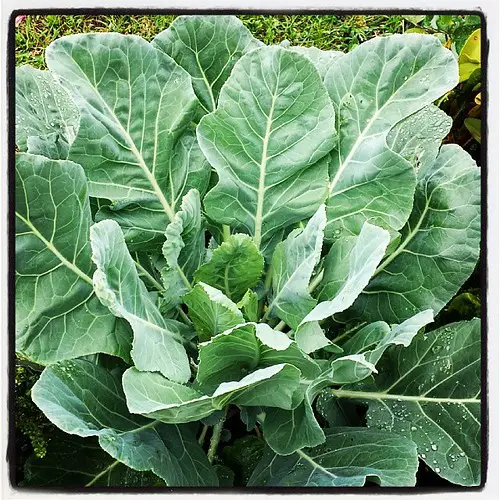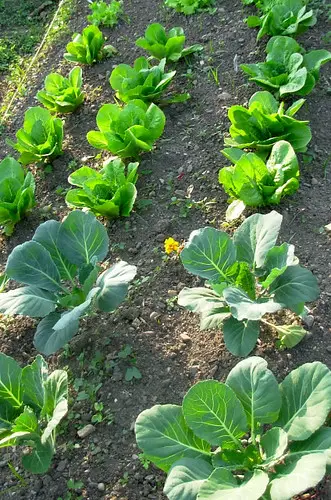Is Spinach And Collard Greens The Same? Spinach and Collard Greens are two of the lesser known leafy Greens that are grown in the garden and are generally less popular than things like silverbeet and lettuce. So are these two leafy Greens just different names for the same thing or something completely different?
Spinach Greens and Collard greens are actually separate and distinct plants that come from completely different plant families. Collard greens are a member of the brassica family while spinach is part of the amaranthaceae family. Collard greens are significantly taller in height than spinach plants and have a cabbage-like leave that reaches 2 to 3 ft tall whereas spinach plants only reach a height of less than 1 foot.
Collard greens have a flavour which is not dissimilar to kale but is somewhat milder in flavour. This flavour becomes stronger when the plant is cooked. Whereas spinach has a milder sweeter taste that is commonly used in salads.

The Nutritional Differences Between Collard Greens And Spinach
Both collard greens and spinach I considered relatively healthy plants to eat though spinach does have a few distinct advantages over collard greens. Spinach has a higher level of antioxidants, iron, omega 3, and potassium. It also has high levels of Vitamin A and K but collard greens has a higher level of vitamin C.
So if you are choosing the plant purely on nutritional value for the most part spinach would be considered slightly superior. To get a full breakdown of this click here
The Cultivation Of Collard Greens And Spinach
Collard Greens and spinach are both generally considered to be winter vegetables, however, collard greens are significantly more heat tolerant than spinach though they do produce the best flavour in relatively frosty conditions. Both plants can tolerate relatively low temperatures typically around 14°F (-10°C).
In terms of yield, collard greens are significantly larger plants than spinach and therefore will yield significantly more leaves than spinach over a substantially longer time so if you’re looking for pure yield then go for something like collard greens.
In terms of the best time to plant seeds, most gardeners tend to sow seeds in late summer which allows the plant to get going in the seed tray relatively quickly just as the weather is starting to turn cooler.
To start the plants off in a seed tray start by filling it with good quality seed raising mix and firm it into the individual cells to create a solid plug. This is advantageous because it allows the seedling to be transplanted without disturbing its roots later on.

Ideally, we recommend sowing two seeds per cell. The depth at which the seeds are sown for the two plants will vary because spinach has substantially larger seeds than collard greens and therefore they tend to be planted a little bit deeper, typically around an inch deep, whereas, collard greens should be planted at around half an inch deep.
If both seeds in a cell germinate then we recommend that you thin the weaker seedling from each cell leaving 1 seedling per cell to grow on.
If you are planting in summer the seeds should be placed in a cool area that is not exposed to too much heat which will allow the seed tray to retain its moisture while the seedlings develop. Typically, seedlings will take approximately 4 to 6 weeks to develop and get to a reasonable size, however, this will vary substantially depending upon the climatic conditions in which you are growing plants.
Once the seedlings have reached a reasonable size, which is typically a couple of inches tall, the plants can be transplanted out into the garden. Typically most gardeners will plants these seedlings in the full sun locations, however, as both plants are grown for their leaves they will tolerate some shade.
Shady conditions can be advantageous in cases where the weather remains relatively warm as it can protect the young seedlings from the heat early on. I personally tend to split my seedlings into full sun locations and partial shade locations such as under a deciduous tree.
In terms of soil conditions, both plants prefer to grow in rich moist and free-draining soil that has plenty of nutrients. If you’re unsure about the quality of your soil you can add a bag of compost prior to planting which will not hurt the growth of the plants.
When planting the seedlings collard greens will require substantially more space than spinach and is typically planted 12 to 18 inches apart. Whereas spinach can be planted as little as 6 inches apart in the garden beds.

When planting seedlings in the ground both plants are susceptible to attack from slugs and snails. It is therefore recommended that you sprinkle some snail bait around the outside of the plants to provide some protection.
Both plants also benefit from having a thick layer of mulch applied around the base of the plants to help to retain moisture and suppress weeds. To ensure high-quality growth it is important to water the plants regularly to ensure that they remain moist.
Harvesting Collard Greens And Spinach
Both collard greens and spinach can be harvested at any stage throughout their life once the leaves reach a reasonable size. It is particularly common to harvest baby spinach leaves which are sold commercially in many supermarkets. However, if you are harvesting plants at this stage it is important to ensure that you leave at least some of the leaves on the plant to allow it to continue to photosynthesize as that will aid in helping the plant to recover allowing less time between the next harvest.
For collard green harvesting of individual leaves can also be done at any stage or the plant can the harvested as a whole. If you are harvesting single leaves it is best to remove those from the outer part of the plant as they will be the oldest leaves. This allows the new growth in the inner part of the plant to continue to develop providing continuous harvest throughout the season.
In areas that have relatively mild winters, both plants can be grown throughout the winter period which will allow harvests to be taken on an ongoing basis for a couple of months which makes them attractive plants to grow in your garden.
Both plants will have a tendency to run to seed after the winter period as the weather warms up at which point you may consider planting a new lot of seeds.
I hope you found this article useful and have great success growing collard greens and spinach at your own house. If you have any additional comments or questions please leave them in the section below.
Relevant Articles
How Much Does A Spinach Plant Yield?
How Long Does It Take Spinach Seeds To Germinate? How Does Temperature Effect It?
Collard Greens Vs Kale: What’s the Difference And How To Tell Them Apart
